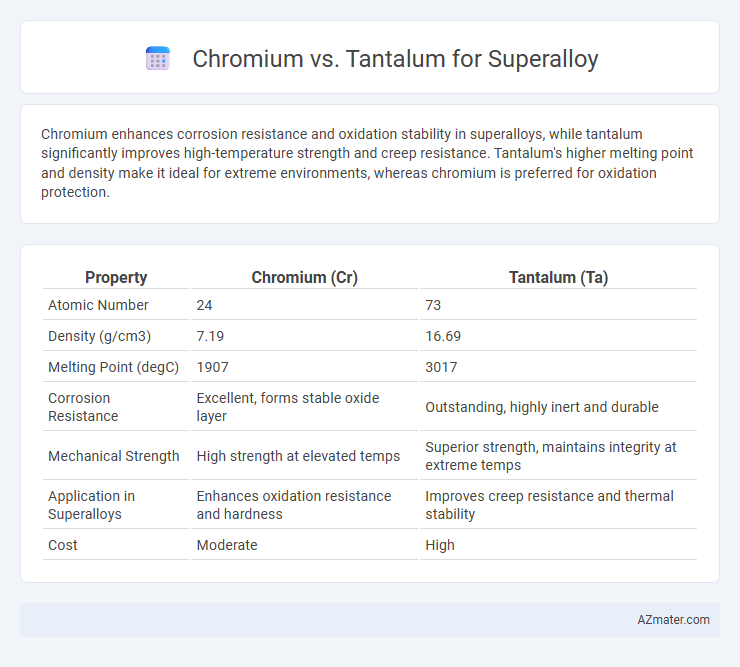Chromium enhances corrosion resistance and oxidation stability in superalloys, while tantalum significantly improves high-temperature strength and creep resistance. Tantalum's higher melting point and density make it ideal for extreme environments, whereas chromium is preferred for oxidation protection.
Table of Comparison
| Property | Chromium (Cr) | Tantalum (Ta) |
|---|---|---|
| Atomic Number | 24 | 73 |
| Density (g/cm3) | 7.19 | 16.69 |
| Melting Point (degC) | 1907 | 3017 |
| Corrosion Resistance | Excellent, forms stable oxide layer | Outstanding, highly inert and durable |
| Mechanical Strength | High strength at elevated temps | Superior strength, maintains integrity at extreme temps |
| Application in Superalloys | Enhances oxidation resistance and hardness | Improves creep resistance and thermal stability |
| Cost | Moderate | High |
Introduction to Superalloys: Importance and Applications
Superalloys, essential for high-performance applications, rely heavily on elements like chromium and tantalum to enhance their mechanical strength and corrosion resistance at elevated temperatures. Chromium improves oxidation resistance and forms a protective oxide layer, making it critical in turbine blades and jet engines. Tantalum contributes to superalloy stability and creep resistance by refining the microstructure, vital for aerospace and power generation industries.
Overview of Chromium and Tantalum: Material Properties
Chromium exhibits high corrosion resistance, excellent hardness, and a melting point of 1907degC, making it essential for strengthening and oxidation resistance in superalloys. Tantalum offers exceptional ductility, a high melting point of 3017degC, and outstanding resistance to chemical attack, enhancing superalloy toughness and thermal stability. Both elements contribute differently: chromium improves surface hardness and oxidation stability, while tantalum increases creep strength and high-temperature performance.
Role of Chromium in Superalloy Performance
Chromium in superalloys significantly enhances oxidation and corrosion resistance by forming a stable, protective chromium oxide layer on the surface at high temperatures. This oxide scale prevents rapid degradation, maintaining mechanical integrity under extreme conditions typical in aerospace and power generation applications. Compared to tantalum, which primarily improves high-temperature strength and creep resistance, chromium's role is critical for surface durability and prolonged service life.
Contribution of Tantalum to Superalloy Characteristics
Tantalum significantly enhances superalloy performance by improving high-temperature strength and oxidation resistance due to its high melting point and stable carbide formation. Its ability to form fine precipitates contributes to enhanced creep resistance and structural stability in extreme environments. Compared to chromium, tantalum provides superior improvements in corrosion resistance and mechanical properties critical for aerospace and turbine applications.
Oxidation and Corrosion Resistance: Chromium vs Tantalum
Chromium significantly enhances oxidation resistance in superalloys by forming a stable and continuous chromium oxide (Cr2O3) layer, which acts as a protective barrier against high-temperature oxidation and corrosive environments. Tantalum, while offering excellent corrosion resistance in aggressive chemical environments due to its stable oxide film, generally provides less oxidation resistance in oxidizing atmospheres compared to chromium. Superalloys leveraging chromium achieve superior high-temperature surface stability, whereas tantalum's primary advantage lies in resisting molten metal corrosion and highly acidic conditions.
High-Temperature Strength and Stability Comparison
Chromium enhances oxidation resistance and contributes to the high-temperature strength of superalloys by forming stable oxide layers, while tantalum improves creep resistance and phase stability at elevated temperatures through its ability to strengthen the gamma-prime phase. Tantalum addition leads to increased refractory element content, offering superior microstructural stability under prolonged high-temperature exposure compared to chromium. In terms of thermal stability and mechanical performance, tantalum-containing superalloys typically exhibit better retention of strength and structural integrity above 1000degC.
Impact on Creep Resistance and Mechanical Properties
Chromium enhances the oxidation resistance and strengthens the grain boundaries in superalloys, significantly improving creep resistance at high temperatures by forming stable carbides and promoting a protective oxide scale. Tantalum contributes to mechanical properties by increasing solid solution strengthening and improving the alloy's microstructural stability, which helps maintain high-temperature strength and toughness under prolonged stress. The synergistic use of chromium and tantalum in superalloys optimizes the balance between creep resistance and mechanical performance, enabling superior durability in extreme aerospace and power generation environments.
Cost, Availability, and Sustainability Considerations
Chromium is significantly more cost-effective than tantalum, with wider availability due to its abundant reserves and established global supply chains, making it preferable for large-scale superalloy production. Tantalum, though offering superior corrosion resistance and high-temperature stability, remains expensive and less accessible because of its rarity and concentration in geopolitically sensitive regions. Sustainability considerations favor chromium as it involves less environmental impact from mining and refining, contrasting with tantalum's complex extraction processes that raise ethical and ecological concerns.
Industrial Applications: Case Studies with Chromium and Tantalum
Chromium enhances corrosion resistance and oxidation stability in superalloys used for aerospace turbine blades, as demonstrated by its application in jet engine components operating under high stress and temperature. Tantalum's exceptional high-temperature strength and resistance to chemical attack make it ideal for nuclear reactors and chemical processing equipment, where durability in aggressive environments is critical. Case studies reveal that superalloys with chromium excel in combustion chamber construction, while tantalum-infused alloys perform better in environments demanding superior creep resistance and thermal stability.
Future Trends and Advances in Superalloy Alloying Elements
Emerging research in superalloy development emphasizes leveraging the high-temperature strength and corrosion resistance properties of chromium while optimizing tantalum's potent refractory metal characteristics to enhance creep resistance and phase stability. Advanced alloy design techniques, including computational thermodynamics and machine learning, are accelerating the precise tailoring of chromium-tantalum compositions to achieve superior performance in extreme environments found in aerospace and power generation. Future trends highlight increasing integration of microalloying with tantalum and chromium to refine gamma-prime precipitate morphology, thus pushing the operational temperature limits and durability of next-generation superalloys.

Infographic: Chromium vs Tantalum for Superalloy
 azmater.com
azmater.com